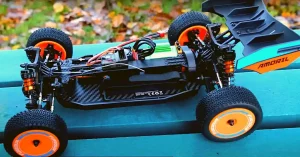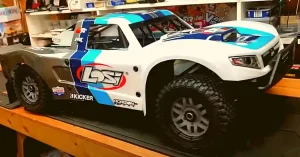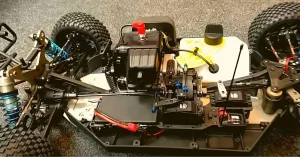RC cars work based on radio signals, power sources and controllers. The radio signal from the controller activates the car’s motor and other electrical components. At the same time, they receive power from the power source. Through the radio signal, the car understands your command and moves accordingly.
However, RC cars have varieties, including electric, nitro and gas-powered RCs. Along with the basic working system, they have their unique working mechanism. Are you interested to know about them?
In this article, we discuss how each type of RC car work and their advantages and disadvantages.
Read and explore.
How Do Electric RC Cars Work
In electric RC cars, the batteries, radio signals and other electric machinery work together to drive the vehicles. They have rechargeable batteries to power the ESC (electronic speed controller).

You can send signals (radio waves) to the receiver inside the car using the handheld controller. The receiver converts them into electrical signals and sends them to the ESC.
The ESC adjusts the power to the motor according to your command and controls the car’s speed and direction. When the motor receives electrical energy from ESC, it converts it into movement and spins the car’s wheels.

This process is the basic principle of how an electric RC car works. But, modern RC cars come with specialized parts, such as gears and suspension systems, to improve the car’s performance.
Even many RCs have sensors and computerized systems for precise stability and control.
Advantages of Electric RC Cars:
- Quieter operation.
- Instant torque and responsiveness.
- Easy to operate for beginners.
- Longer run times per battery charge.
Drawbacks of Electric RC Cars:
- Longer charging times.
- Battery replacement over time.
- Limited speed compared to other RCs.
- Less suitable for extreme off-road conditions.
How Do Nitro RC Cars Work
Nitro RC cars work based on nitro engines, real car engine that runs by burning nitro fuel. The engine comprises several parts, including the carburetor, piston, crankshaft and glow plug.

Before starting the car, you need to activate the glow plug using a glow plug igniter. After that, you can start the car by pulling its engine’s string.
The carburetor of the nitro RC car takes fuel from the tank and mixes it with air. The device manages the amount of fuel and air to go into the engine and controls how fast the engine works.
When a fuel-air mixture is formed, the engine’s piston squeezes the blend and the heated glow plug makes it burn precisely. The burning process moves the piston and generates power to pass the energy to the wheels through the transmission system.

For controlling the steering, nitro cars use a servo mechanism. The function is controlled by a transmitter which sends the signal to the car’s receiver whether you want to go left or right.
Advantages of Nitro RC Cars:
- Realistic engine sound and experience.
- Higher speeds and acceleration.
- Longer run times compared to electric cars.
- Refueling allows for uninterrupted driving.
Drawbacks of Nitro RC Cars:
- Louder operation.
- Higher maintenance requirements.
- Regular engine tuning and adjustments.
- More complex starting procedures.
How Do Gas-Powered RC Cars Work
Gas-powered RCs are other RC car whose engine requires gasoline and oil as power sources to work. They come in two variations, including the two-stroke and four-stroke engines.

To start the gas-powered RC engine, you have to pull its string. After that, the carburetor takes fuel from the tank and mixes it with air for burning. However, the two- and four-stroke engine’s working mechanism is slightly different.
In a two-stroke engine, the piston completes two cycles, moving up and down twice to generate power and clear out waste gases. In a four-stroke engine, the piston moves up and down four times to complete different tasks, including fuel intake, compression, combustion, and waste gas discharge.
By burning the fuel-air mixture, the engine generates power and distributes the energy to the wheels through a system of interconnected parts. These components include the transmission and the drive train.

This mechanism generates power and utilizes the energy to spin the wheels of the RC car. However, gas-operated RC cars also use a servo mechanism for motion control like the other RC vehicles.
After connecting the handheld transmitter to the receiver inside the car, you can control its motion and guide how you want to move it.
Advantages of Gas-Powered RC Cars:
- Realistic engine sound and experience.
- Higher speeds and acceleration.
- Longer run times compared to electric cars.
- Refueling allows for uninterrupted driving.
Drawbacks of Gas-Powered RC Cars:
- Louder operation.
- Higher maintenance requirements.
- Regular engine tuning and adjustments.
- More complex starting procedures.
Frequently Asked Questions
Q. Are nitro and gas-powered RC cars the same?
Nitro and gas-powered RCs are different types of RC cars as their engines are distinct. Moreover, they have different fuel requirements and combustion processes.
Q. What kind of radio systems are used to control RC cars?
A transmitter-receiver based radio system controls RC cars. The frequencies of most RC cars are 2.4GHz or 900MHz.
Q. What are glow plugs and spark plugs in fuel-based RC cars?
Glow plugs are used in nitro RC cars to ignite the fuel-air mixture for combustion. In contrast, spark plugs are used in gas-powered RC cars. It creates a spark to ignite the fuel-air mixture.
Final Words
Though RC cars have varieties; each offers unique features and thrills. A question may come to your mind that why you should understand the working process of your RC car! Well, it can be beneficial from many aspects and help you understand the car better. When you have precise knowledge about how your RC car works, you will be able to troubleshoot its issues more accurately. Besides, you will be better at caring for the car for long-lasting optimal performance.


